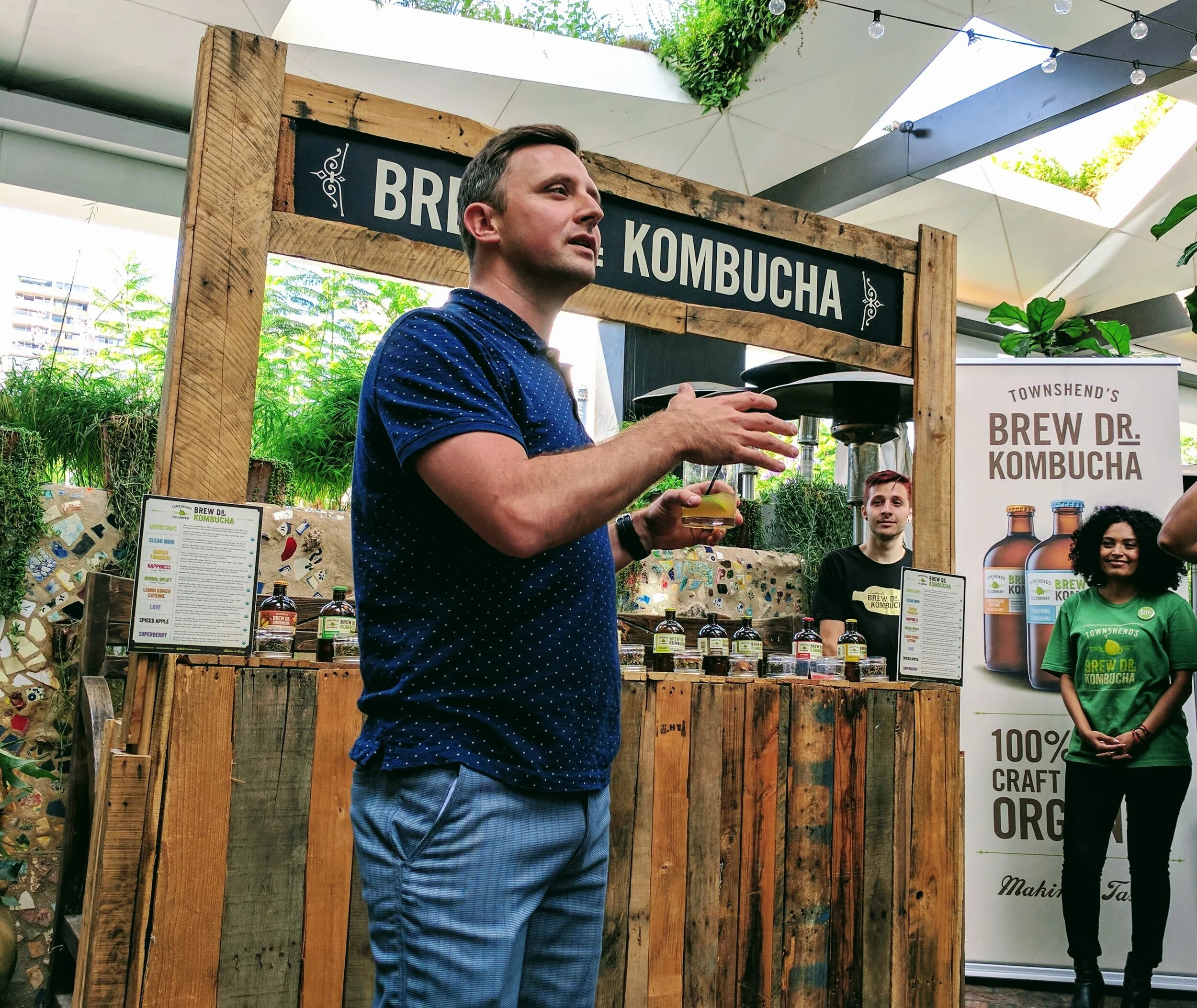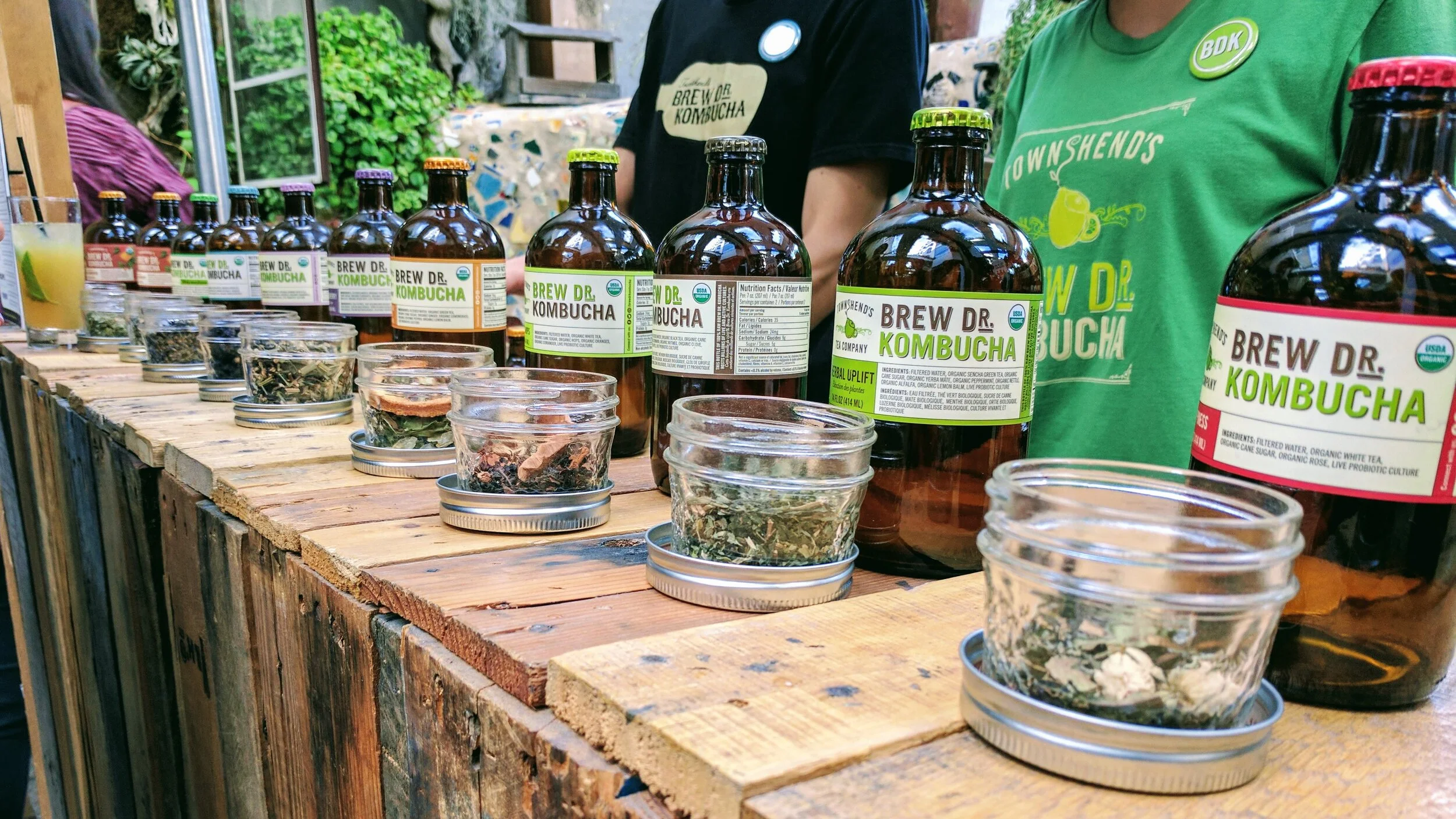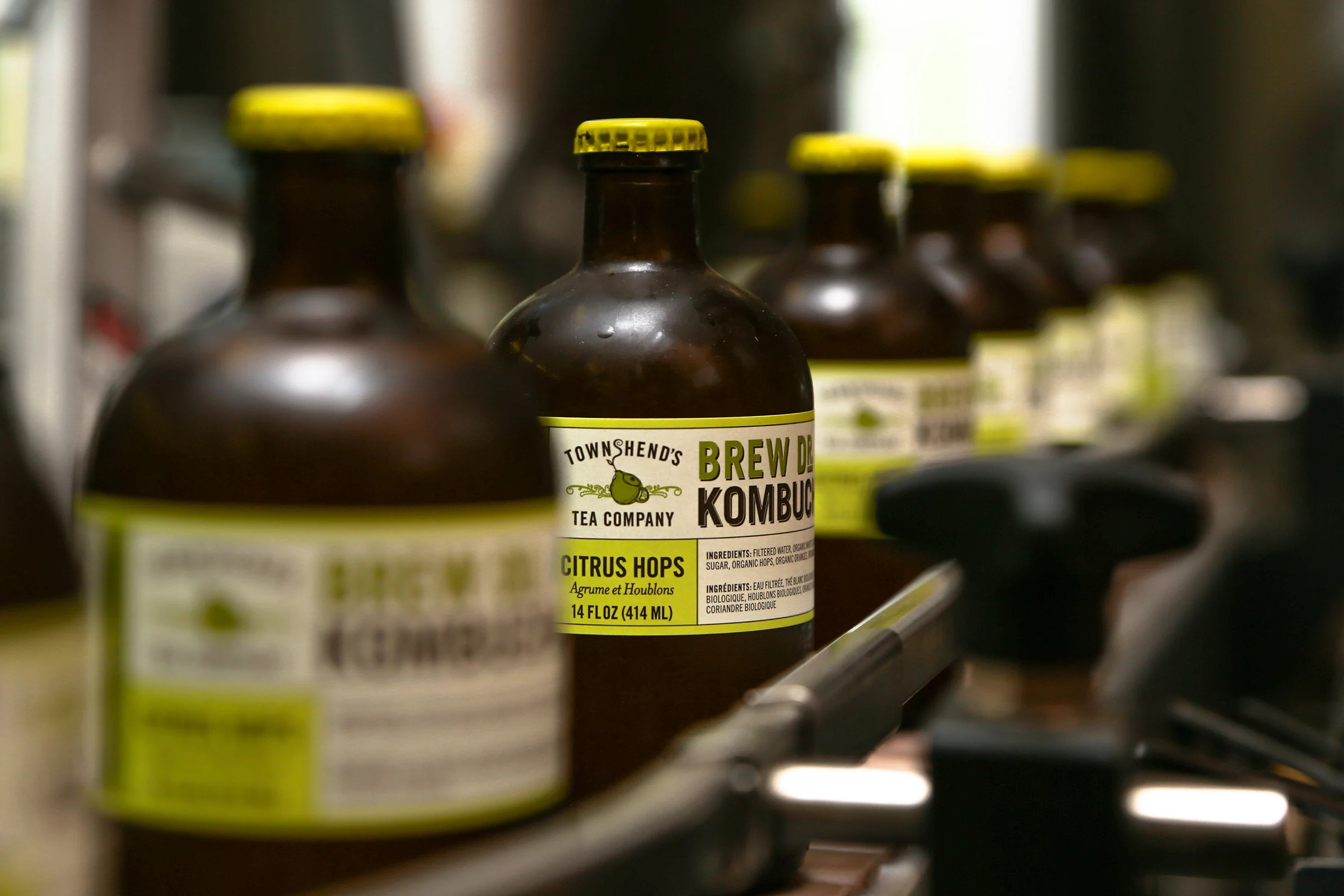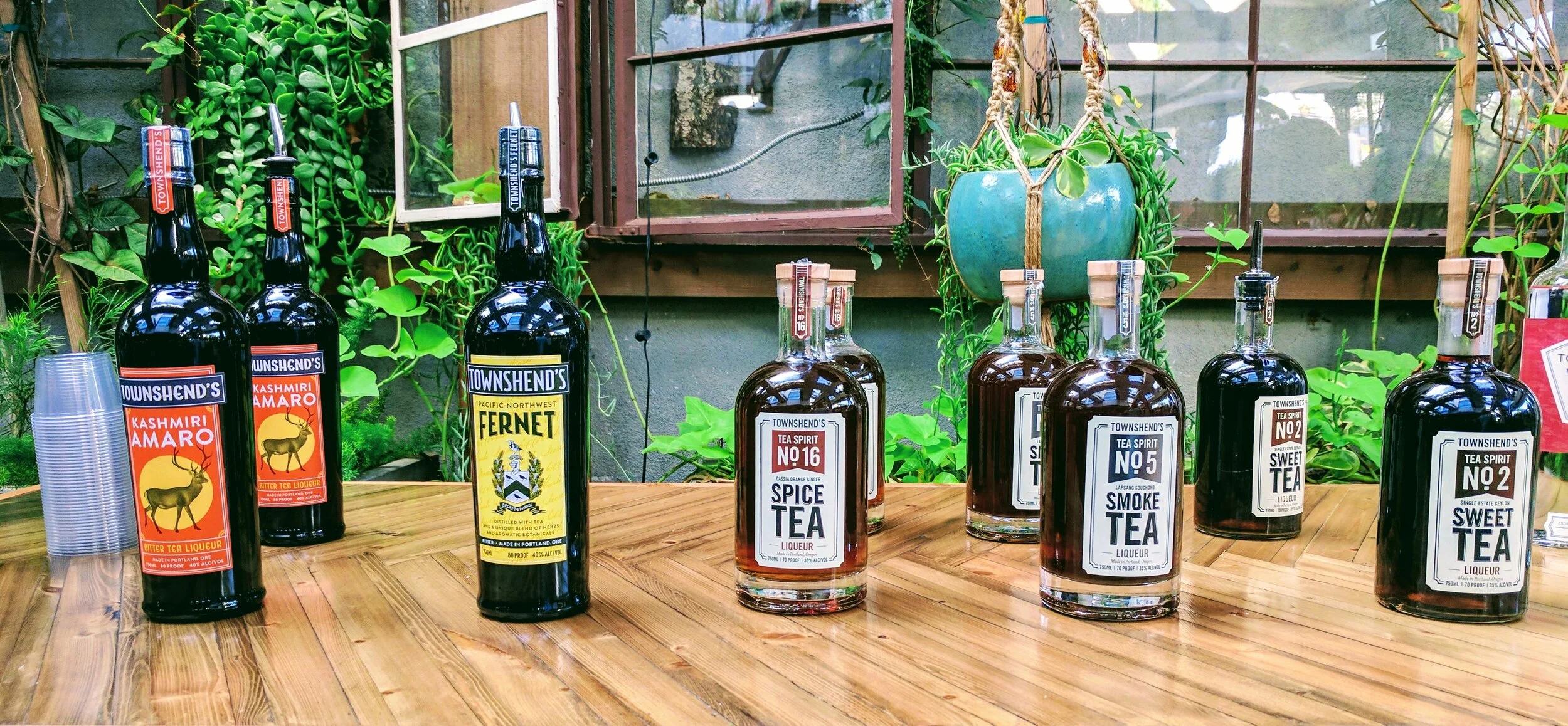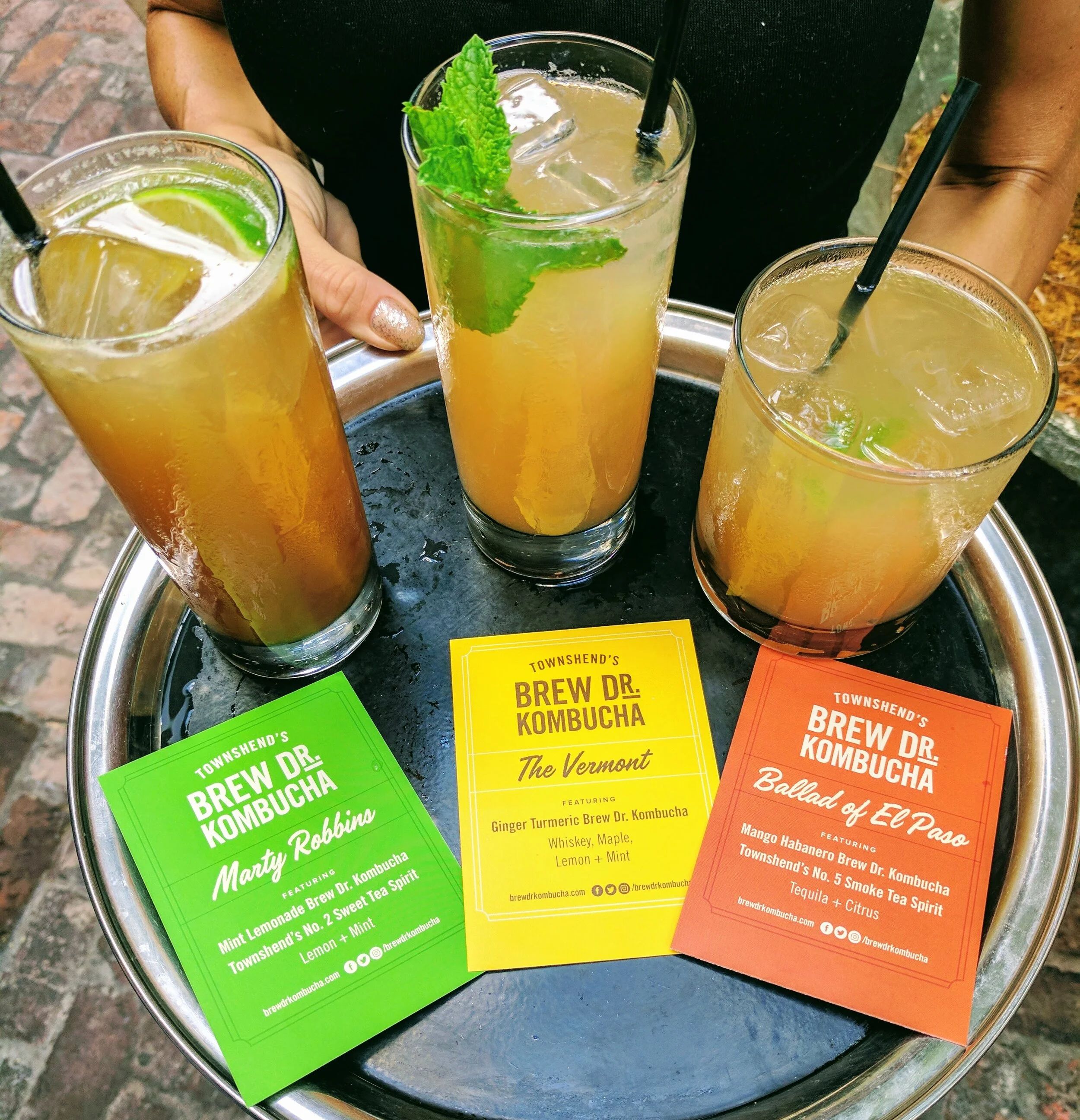Meet the World’s Only Triple-Threat Tea Company
There I was, attending a swank cocktail party hosted by Brew Dr. Kombucha in West Hollywood on a hot July day, sipping on a “Marty Robbins” cocktail, talking to Marty Wall about the tea industry, kombucha, and spirits. The “Marty Robbins” is made with mint, lemon, Mint Lemonade Kombucha, and Tea Spirit No. 2 and is deliciously sweet. Marty Wall is a seven-foot tall, spectacled man who’s the Executive VP of Business Development for Brew Dr. Kombucha, and happens to also be sweet.
Marty and I chat about the tea and coffee industry and commiserate at how difficult burgeoning products and trends are to predict. The former Vice President of Sales for Stumptown Coffee, Portland’s shining coffee beacon, Wall recounts how he was completely blindsided by the unlikely rise of nitro coffee. He rejected it outright as a fad. Only a few years later, nitro coffee is a featured offering at Starbucks. “Who would’ve thought it?”, he said. I commented that his current company’s main product is a fungus-fermented vinegary sparkling tea with living bacteria in it. “Who would've thought that would catch on?”, I noted. But Wall isn’t discouraged. His company has had an equally unlikely evolution, multiplying into three companies in three separate fields of business like some sort of amoeba, namely, a series of retail tea shops and cafes, ready-to-drink and kegged kombucha, and bottled spirits and liqueurs.
Matt Thomas, Founder and CEO.
At the head of this beverage trinity is Matt Thomas, founder and CEO, who broke down the evolution for me. What started as a Business School Project for him at the University of Oregon (which he was told wouldn’t work because it was too risky), turned into an actualized tea retail shop specializing in premium loose-leaf tea for the average consumer. He saw that tea was growing in the market and was willing to bet that customers would pay for better quality loose tea. His gamble paid off. Evoking the Townshend Acts, those taxes on tea and other goods that led to the Boston Tea Party, Townshend’s Tea Company was founded in 2006 in Portland, Oregon.
Their tea lineup is entirely loose-leaf and covers your basics: a good quality jasmine pearl, a classic lapsang souchong, a smattering of sencha, Assam, Ceylon, with the majority edging toward simple blends that your average customer will enjoy like Earl Grey, Rose Peony (Bai Mu Dan with rose), and herbal blends. Quality was always important. The community responded and Thomas was able to open another Portland-based Townshend’s Tea in 2008. But Portland being Portland, it was only a matter of time before Thomas heard about kombucha.
Regular customers would come in and ask if they carried kombucha. They didn’t at the time, but with so much tea on hand, it was a logical next step. As strange as the beverage was, they could clearly see the interest and figured it was worth a shot for their customers. The fermentation started in their basement, SCOBY and all, and they soon began to bottle their own blends. Townshend’s kombucha was an immediate success and they had to work around the clock to make enough to meet demand. When it was clear they had something great on their hands, Thomas got a small Local Producer Loan from Whole Foods (the first in Oregon) and outfitted out a workshop and warehouse into a full-blown kombucha brewery. Brew Dr. Kombucha was born.
Brew Dr. Kombucha, and the Townshend’s Tea they’re made from.
Brew Dr.’s philosophy has always been simple: make kombucha using quality tea, herbs, and spices. To separate themselves from the competition, they refrain from adding flavoring, juices, or fruit purees after fermenting. The result is a clean, lightly tart, lightly sweet and nuanced kombucha that tastes more like a mixological digestif than a juice you buy at the grocery. For instance, their best-seller, “Clear Mind”, is a simple combo of green tea, rosemary, peppermint, sage, and dandelion root. Unlike most kombucha brands, many of their flavors lean toward subtle and floral. Townshend’s Rose Peony blend, mentioned above, comprises their “Happiness” kombucha and their “Superberry” is brewed from their loose tea of the same name, with the addition of an oolong base.
By being one of the first to jump in deep with kombucha, keeping their commitment to quality, and because of the unique easy-drinking kombucha they produce, Brew Dr. currently projects $50 million in revenue by 2019. But it wasn’t always smooth sailing and exponential growth…I’m talking about 2011, when Lindsey Lohan happened.
One cannot separate out the celebrity effect on consumer culture or how that effectively creates a “tipping point”, as Malcolm Gladwell calls it. Just as vodka went from a relatively obscure Russian liquor to one of the most consumed in the United States via the chic popularity of James Bond and the distinctive look of the Moscow Mule (during the Cold War, nonetheless), kombucha, also a relatively obscure Russian drink, was put on the public radar by Lohan. While under house arrest, Lohan failed an alcohol test but claimed to have only been drinking kombucha, not the hard stuff. As ridiculous as this claim was, it was likely the first time millions of Americans heard the word. And with that public spotlight, regulation stepped in.
It turned out that kombucha brewers were paying very little attention to how they were fermenting and bottling their beverages. Kombucha is fermented with a SCOBY (Symbiotic Culture Of Bacteria and Yeast), a living colony of fungus and bacteria. Typically, this would be an open fermentation, meaning that live yeast cultures are present, with little control over the exact ratio of yeast to bacteria, and when you combine yeast with sugar and fermentation: you get alcohol. Although most kombucha was relatively benign, being under 1% ABV (Alcohol by Volume), some were found to have been as high as 3%. Kombucha was swept off the shelves and new regulations were put into place that demanded all kombucha be bottled at 0.5% or lower. Many companies diluted their brews with juice, purees, or more sugared tea. But how did Brew Dr. deal with the new regulations without sacrificing quality?
Citrus Hops Kombucha; image courtesy of Brew Dr. Kombucha
Enter the vacuum still, or more technically, the SCC (Spinning Cone Column). Traditional stills for making spirits get to very high temperatures to extract the ethanol away from a fermented beverage, thus distilling it. This would be too hot for kombucha, killing the living cultures within it, but an SCC does this process with vacuum steam distillation, which can extract ethanol at just under 100ºF. Although expensive, these vacuum stills checked all the boxes for what Brew Dr. wanted to accomplish. There was something else though…
After processing the kombucha down to the proper ethanol levels, they now had leftover kombucha distillate..."bucha-booze", if you will. Thomas saw an opportunity, and rather than waste the large amounts of ethanol he was producing, he repurposed it into a new company, Thomas & Sons Distillery, now called Townshend’s Distillery. Maybe you can see where this is going…
Townshend’s Tea Company imports and blends loose leaf tea and herbs.
Brew Dr. Kombucha brews those teas into kombucha and extracts the ethanol to lower the alcohol content.
Townshend’s Distillery turns that ethanol distillate into tea spirits.
Triple whammy.
Some of the Townshend’s Distillery lineup.
Some spirits are a straight line, like the Rose Peony tea from before, which is turned into Happiness kombucha, which is then distilled into White Rose vodka. Given their resourcefulness, it won’t surprise you that the distillery employs an array of techniques to produce a broad range of spirits, including an amaro, a fernet, a gin, and four liqueurs, many of which are re-infused with their loose tea blends. Take their “Tea” liqueurs: All start with the kombucha distillate. Tea Spirit No. 2, “Sweet Tea”, is re-infused with a Single Estate Ceylon and Tea Spirit No. 5, “Smoke Tea”, is re-infused with lapsang souchong.
Kombucha cocktails (in more ways than one).
We've explored tea infusions into cocktails, but never tea distillates. These are serious spirits. Their Kashmiri Amaro, which is re-infused with one of their chai blends, is rich, bitter, and complex enough to hold its own on some of the best bar tops in the country, alongside amaro old and new (tea people have a thing for amaro). Their Pacific Northwest Fernet is distinguished by the tea based distillate and an infusion of 30 local ingredients.
The “Marty Robbins” cocktail itself is a perfect encapsulation of the tea entanglement at work here:
Tea brewed into kombucha, which is spiked with a spirit distilled from kombucha and re-infused with tea.
Again, "Who would've thought it?", I said. Marty Wall certainly couldn't have, just like he couldn't have predicted the success of nitro coffee. Nor could Matt Thomas have predicted that his business school project, which was rejected for being too risky, would turn into a three-tiered beverage powerhouse. Talk about unlikely.
BONUS: The “Marty Robbins” Recipe
* Title image courtesy of Brew Dr. Kombucha.
* All other images by the Author.

